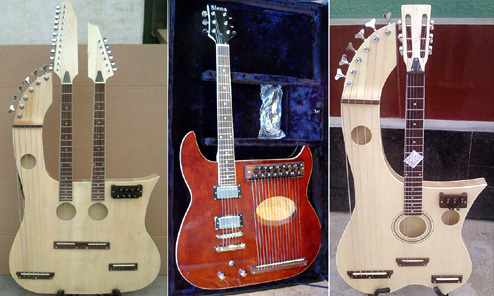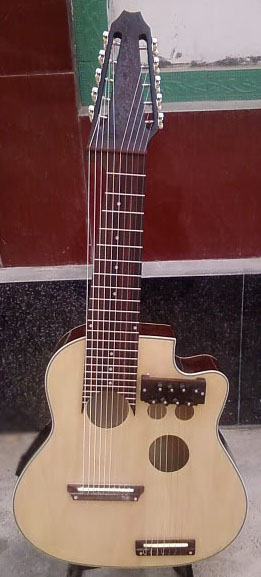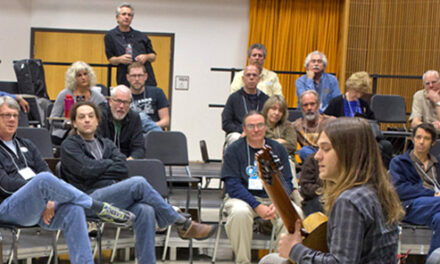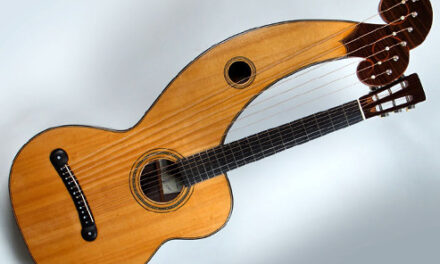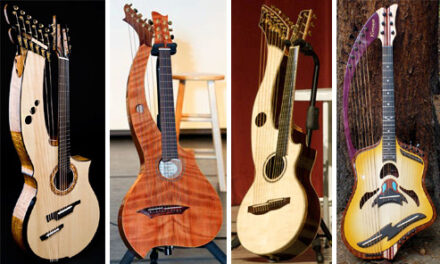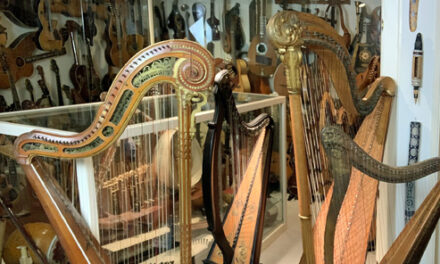I recently received the email below and thought I should answer in more detail, and share it with everyone here, as it covers ground I am asked continually.
“I’ve perused your forums, however I’ve been unable to find anything in regards to this vendor on eBay: (the link went to the instrument at left-GM) While I have read a bit about Tropical Moon, I’m not sure if this is the same vendor under a different name. I’ve always wanted a harp guitar, but I’m most likely going to buy an 8-string electric first to get a taste of playing with extended range. For a few years, I’ve pondered which route to go, either investing in a harp guitar, getting a classical 10-string, or a baritone guitar. There are some well-made 8-strings available from Rondo Music that have gotten very good reviews. My question is this: Is this a fake? Do you think it would be even close to playable? The picture looks nice, but of course I am very doubtful a functional guitar of this nature could be made for under $400, even in China. What do you think?
Thanks so much, Javen Maves”
Javen asks several questions here, and I’m going to take at least 2 blogs to address them.
Let me briefly address: Harp guitar vs. Classical 10-string vs. Baritone guitar
First, I would hate to see finances influencing this decision, but with new entry-level instruments entering the market all the time, I expect this will become much easier. The 3 instruments mentioned are somewhat different animals, utilizing some different techniques. The common theme is that they each provide low notes (why Javen is asking, I bet), but in different ways. They are also each usually a “second instrument” or at least an instrument one approaches through first learning the 6-string guitar.
Theoretically, a Baritone would be the easiest to adapt to, as it is still just 6 strings. These days, “Baritone guitar” typically means steel-string fingerstyle, but nylon and numerous electric versions have long been available. It typically tunes down a 4th or 5th below the guitar.
By definition, “classical guitar” implies nylon strings. One with 10 or more strings can give the range and effects of a comparable harp guitar, and of course, provide all the in-between low chromatic notes that most harp guitars do not (and certainly not in the same way). In this case, the left hand might be doing more than on a harp guitar, with the right hand similar.
Harp guitars are actually easier for the left hand, but still harder (or initially confusing) for the right hand. This is just my perspective. While the other 2 options can be pretty narrowly defined, harp guitars are not. Here I’d suggest reading a couple of articles:
Shopping for the Perfect Harp Guitar
Harp Guitar Instructional Resources, Part 1
Bottom line: It boils down to you, and what kind of music you want to play.
Now on to your instrument questions. I’m not familiar with Rondo or their 8-string. I am familiar with Tropical Moon and some of their instruments and am happy to rant, er, discuss that. One of my Public Service Announcements at Harp Guitar Music is on this very subject. If every eBay shopper would read these before bidding, I’d probably get a lot fewer emails. There, my focus is largely on their then-rampant intellectual theft. I haven’t seen a Doolin rip-off in a while – perhaps Mike’s letter to them helped. The other issue then was that they would simply steal photos off my site (the Sedgwick for example) and include that as the “actual instrument” they were selling. The scam being that if people bid, they would then simply build as many crude knockoffs as needed to fill orders. The instrument sent might vary significantly, but I imagine in many cases uneducated buyers would just take their lumps. From what I’ve heard, the company would accept returns and give money back, so perhaps there’s hope yet.
One thing I can’t answer is: Is this even the same Tropical Moon? Hard to say, but likely. They have constantly used different eBay accounts for their listings (I can’t comment on the legitimacy of their “feedback”), and they also like to apply random “brand names” –especially “folksy” American terms (like Tennessee) – to various inexplicable instruments as well.
Whoever this company was/is, the advantage to shoppers now is that they seem to be at least showing a real instrument they have built. You may or may not get that exact one, but at least you can tell it’ll be pretty crappy, right? Javen asks if “this is a fake.” A fake in what way? I’d call it a “fake professional instrument,” if that’s what he means, but no, it’s real enough (shudder). You’ll get something like that, and half the time, it might even be playable (but doubtful). One fellow wrote about one where they installed the bridge so that the octave fell at the 11th fret! Another brought one of the first “Doolin-rip-off HGs” by, and it actually sounded better than the Lark in the Morning. But he paid several hundred dollars and then had to put another several hundred into it to get it to be remotely usable. Still, intrinsic value remains (IMO) at only about $99, which is what some of their opening bids are (or should be).
The real question should be, “but why are they so ugly?” The one Javen pointed out is not as bad as most, but certainly has no finesse or artistry (or practicality) in the “treble” attachment. It’s these “harp” instruments that kill me.
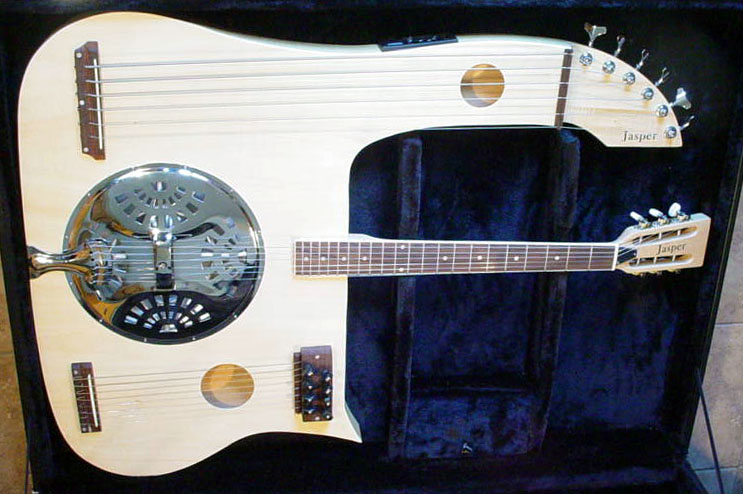
Here’s my favorite! They apparently went from crudely copying really wild existing instruments from the web to creating Frankenstein’s monster instruments that make virtually no sense. This one (which they call the “Jasper”) combines a “folk art” Wishnevsky harp guitar bass section with a resonator guitar along with an original “harp bank” of simplistic design with zero harmonic curve (like the one Javen asked about at top). But could anyone play it? The string banks are all a mile away from each other! Nor do they understand the “sub-bass” or “super-treble” concept. They usually just put a set of regular guitar strings on all of their various banks. But that’s OK because the tuners won’t hold pitch anyway. It’s all just for show, apparently.
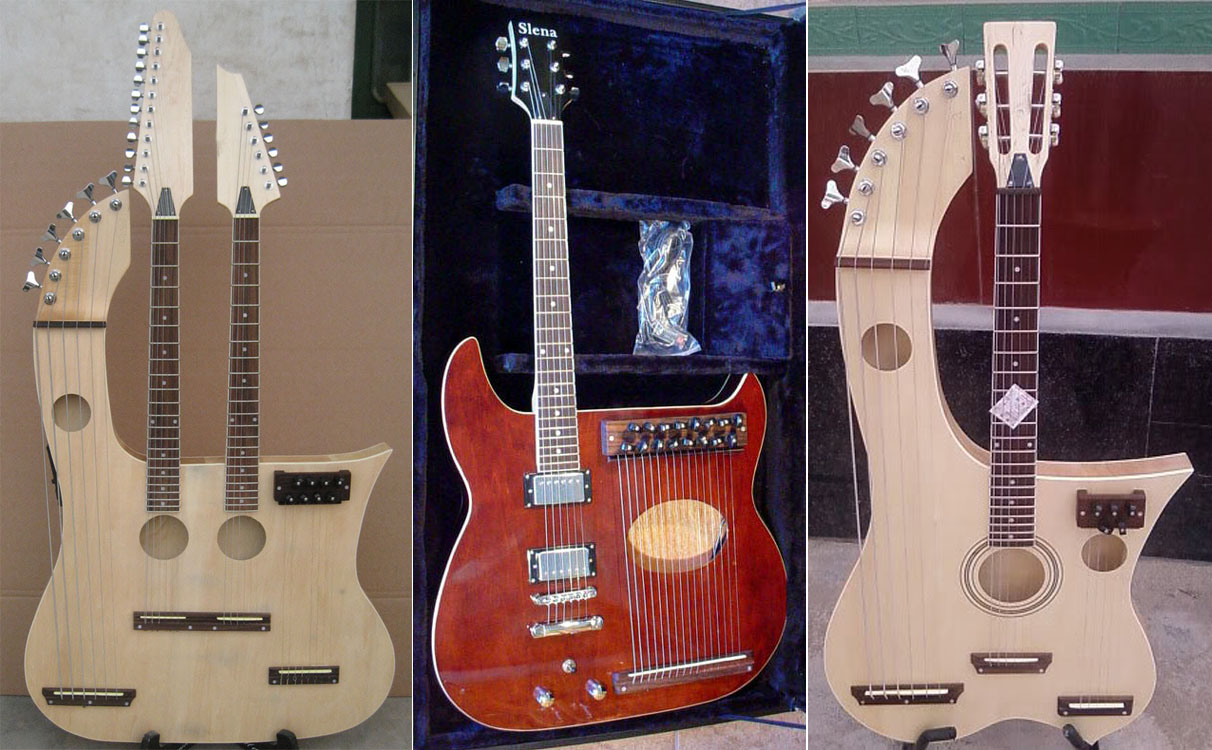
Here are more from the same company, and I’ve seen some of them offered secondhand from private (and probably disappointed) owners.
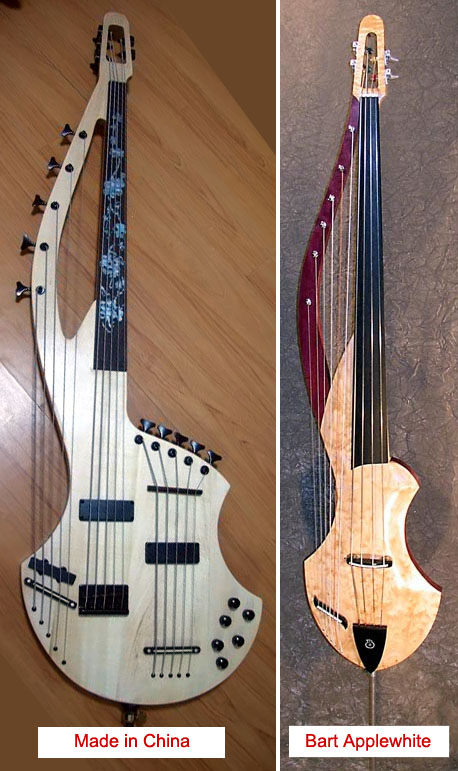
When they do copy some instrument from my site, they are still weird and crude, but perhaps a bit more aesthetic. This one (left) was obviously copied from pro builder, Bart Applewhite’s one-of-a-kind electric harp-bass (right).
Mind you, normally I try to be more diplomatic and “politically correct” in my comments about others’ work. But I have no qualms about trying to prevent unsuspecting or gullible musicians from wasting even 99 bucks on anything from this company.
Sadly, all these instruments just give harp guitars and China both a bad name. Because there are great instruments coming out of China. I’ll talk about them in a day or two. For now, you’ve learned what not to buy. Next will be good news.

